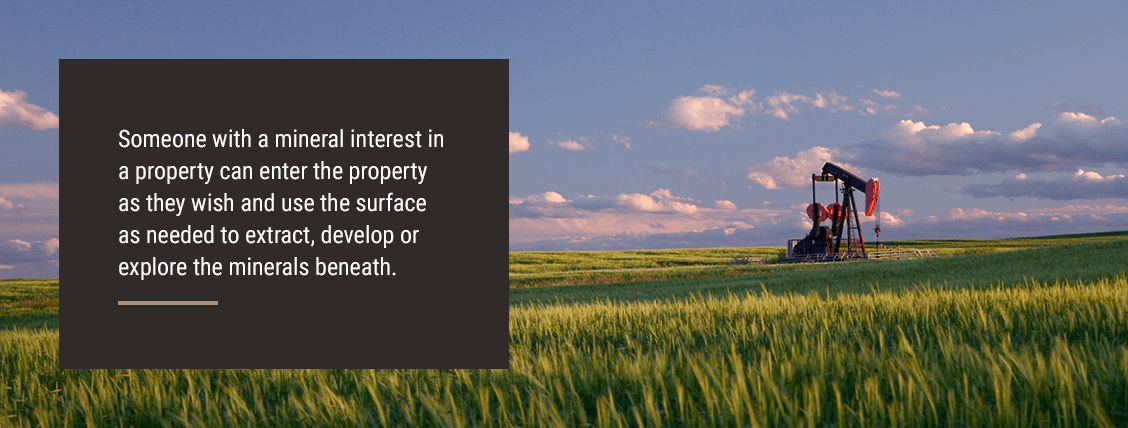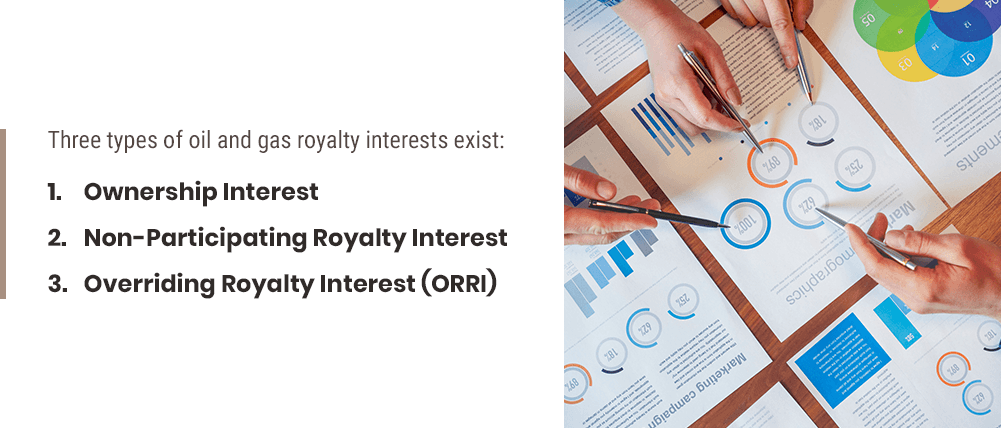Table of Contents:
- Types of Mineral Interests
- Mineral Interest
- Working Interest
- Non-Executive Mineral Interest
- Royalty Interest
- Mineral Interests Vs. Working Interests
- What Is a Royalty Interest In Oil & Gas?
- Types of Oil & Gas Royalty Interests
- Get a Free Mineral Rights Valuation
The United States is just one of a handful of countries that allows citizens to own the minerals, oil, gas and rocks found beneath the land’s surface. In most countries, anything located under the ground is the government’s property. If someone living in one of the countries that don’t allow citizens to own the minerals below the surface wanted to sell or extract the material, they’d have to get permission from their government.
In the U.S., landowners have full enjoyment of their property, including what’s above and below the surface, due to an ownership structure called fee simple ownership. They have the option of splitting their estate, which severs the rights to the minerals below ground from the ownership rights of what’s on the surface. If you are curious about the process of selling your mineral rights, it helps to become familiar with the terms used in this industry and the various types of mineral and royalty interests available.
Are you interested in selling your minerals or mineral royalties? Contact us today for a free valuation.
Types of Mineral Interests
The different types of mineral interests determine how much sway an owner has over the land and how much they are entitled to receive from the extraction or sale of their minerals. Below, we’ll explore a few different types in more detail and outline how mineral royalty rates and payments work in various situations.
Mineral Interest
Someone who has a mineral interest in a property has full executive rights to the minerals found on, in, or beneath the land. They can explore the minerals, develop them and arrange for mineral production. They can receive royalties, rental payments, and lease bonuses for the minerals found on the property.
A company or individual can acquire a property’s mineral interest from a fee-simple owner, thereby severing the minerals from the surface. In this instance, the original owner can retain full control of the surface while a completely separate individual or company owns and manages the mineral rights. In separating the minerals from the surface, the mineral ownership takes on a life of its own with its own chain of title through the years.
An entity or individual can also own just a portion of the mineral interest. When an owner possesses less than 100% of the mineral interest, they own a fractional mineral interest. Individuals who inherit the mineral interest from their parents or grandparents might end up owning fractional interests as well.
For example, a parent might leave their three children equal shares of the mineral interest. Each child owns 33% of the mineral rights. When those children pass away, they leave the right to their own offspring, further fractioning the mineral interest.
Having a mineral interest in a property entitles an individual or entity to the following:
- The right to receive a leasing bonus.
- The right to delay rental payments.
- The right to execute a lease and transfer the rights to the lessee.
- The rights to royalties from production.
- The right to produce, develop or explore minerals beneath the surface.
Another thing worth mentioning about mineral interest is that it is stronger than surface interest. Someone with a mineral interest in a property has the right to use the surface as needed to extract, develop or explore the minerals beneath. This is why minerals are commonly referred to as the “dominant estate.”
Working Interest
A mineral interest owner can enter into a lease with a company that wants to drill wells on the land for mineral extraction. The lease gives the oil or gas company a working interest in the property. With a working interest, the company has the right to develop, produce or explore minerals found beneath the surface (and pay for it all).
The entity that holds the working interest takes care of the expenses associated with drilling and extraction. Their portion of the proceeds is equal to the production revenues less all the royalties that are paid out to the mineral owners. If they pay an average royalty of 20% to royalty owners, this may seem like a lot. However, the 80% of production revenues they receive has to cover the millions of dollars they spent drilling, completing, and producing the well. Many folks don’t realize that the oil companies are operating in the red until a well “pays out,” which is the point when they’ve accrued enough revenue to break even on the drilling and completion expenses. A well usually takes years to pay out, and if an operator has bad timing with oil prices, sometimes they never do. Luckily, the royalty owners get paid along the way, even if a well never pays out!
Non-Executive Mineral Interest
A non-executive mineral interest (NEMI) is similar to a full-fledged mineral interest. The most significant difference is that an individual or entity that holds a NEMI does not have the ability to enter a lease. Instead, someone with a NEMI can earn lease payouts and royalties. Usually, the size of the royalty payments and lease payouts is determined by the primary mineral interest owner.
It’s common for people who inherit mineral rights to receive a NEMI for oil and gas. A landowner might also decide to cede their executive rights to the minerals when they sell the land’s surface but wish to retain a non-executive stake in the mineral interest.
Royalty Interest
After signing a lease with an oil or gas company, a royalty interest will be calculated in any wells that are drilled and produced using the royalty percentage set forth in the lease (“lease rate”). This royalty interest gives the owner a portion of the drilling or extraction revenue without paying for the extraction process themselves.
Often, the royalty interest is described on the lease as a percentage or fraction. For example, let’s assume an owner signed a lease for a 20% royalty. This royalty isn’t for 20% of all oil and gas pulled out of the ground; it must be proportionately reduced to the number of net mineral acres contributed to an owner’s lease against the drilling unit as a whole. For example, if you leased 10 net mineral acres at 20% and the operator successfully drilled a 2-mile well, there will be around 1280 net leasehold acres sharing in that well (the “drill spacing unit”). This means your net royalty interest is 20% * (10 NMA/1280).
The mineral royalty interest exists for as long as the company that leases the land continues to drill. Once the drilling stops, the interest is gone. At that point, the mineral interest holder can lease working interest to a different company. In some cases, a mineral rights owner might have several leases going simultaneously, depending on each one’s clauses and terms.
Mineral rights owners might decide to sell royalty interest to a separate party, retaining the executive rights and mineral interest. Two examples of royalty interest that mineral rights owners may take advantage of include non-participating royalty interest and overriding royalty interest.
Mineral Interest vs. Working Interest
Simply put, the person who takes the lease from an owner (“Lessee”) is the working interest owner. They take on all the risks and pay all the expenses of drilling and completing well(s), but their right to explore for and develop minerals ends once a lease terminates pursuant to its terms. The mineral interest owner is the person granting the lease to a company or agent thereof (“Lessor”). Throughout everything, the mineral interest holder has full rights to the property and full ownership of the minerals that might exist there.
What Is a Royalty Interest in Oil and Gas?
What is the definition of royalty interest – oil and gas? When someone has a royalty interest in oil or gas, they own a part of a resource or have a right to some of the revenue the resource produces. The owner of a royalty interest doesn’t have any responsibility for the cost of operating wells or drilling for gas or oil.
Three types of oil and gas royalty interests exist:
1. Ownership Interest
An ownership interest might be the most common type of royalty interest. Someone with an ownership interest owns the property, as well as the rights to what’s beneath the surface of the land. A company that wishes to drill into the land to extract any oil or gas found beneath it has to take a lease from the mineral owner before they can begin operations.
Usually, the company offers to give the owner a royalty payment. The payment might include a sign-on bonus along with the royalty interest payment. The lease rate the owner receives depends largely on (i) the competition for leases, (ii) perceived risk (i.e. an unproven area will fetch lower royalty in exchange for the risk taken on by the operator), (iii) oil price, and (iv) long-term well economics.
A landowner can sell part or all of their royalty interest if they need or want to.
2. Non-Participating Royalty Interest
Like an ownership interest, a non-participating royalty interest (NPRI) is a non-cost-bearing interest in oil and gas production. If a landowner wants to sell their property but maintain a stake in the payments for the oil or gas beneath the surface, they might reserve an NPRI, allowing them to keep a stake in the profits. Similar to when minerals are severed from the surface, NPRIs are essentially royalties severed off the minerals.
Non-participating royalty interests are called so because unlike the mineral owner, they do not get to participate in lease signing bonuses, rental payments, or the lease negotiations themselves; they just enjoy the production proceeds that are derived therefrom. An example of an NPRI would be if a mineral owner were to carve off 3% NPRI from their negotiated lease rate. Referring back to the 20% lease example under the Royalty Interest section above, that would mean the mineral owner now gets a proportionate share of production based on a 17% royalty, while the NPRI owner gets 3%.
In some cases, a landowner might decide to sell an NPRI when they need cash. If a landowner needs several thousand dollars to do something like make a big purchase, cover medical bills or complete a renovation, they can enter into an agreement with an individual or company. In exchange for a lump-sum payment, the mineral owner can offer the individual or business a percentage of the royalties on the land.
When production begins on the land, the person or company who bought the NPRI will begin receiving payment from the operator based on the percentage defined in the royalty deed.
3. Overriding Royalty Interest (ORRI)
Remember working interest owners (“Lessors”)? Well, let’s bring it back to them. ORRIs are additional burdens created on a lease by a Lessor, usually at the time when they sell a lease to another oil company. For example, if a landman took an 18.75% lease from you, they can sell it to another oil company while reserving a 1.25% ORRI. This doesn’t subtract from what the mineral owner gets paid, it just adds another royalty burden to what the oil company has to pay. Now they’re on the hook to pay 18.75% to the mineral owner, and another 1.25% to the landman. Unlike mineral and royalty interests, ORRIs run with the lease and not the land. That means they’re in effect for only so long as the lease is in effect – they expire when the lease expires.
Historically, it’s been typical for geologists or landmen to receive payment for work with ORRIs rather than cash day rates. When the wells came in good, this was a pretty sweet deal! When the wells were dry holes, the geologists and landmen went back to their day jobs.
Are You Considering Leasing Your Minerals?
How much are the minerals beneath your land worth? If you’re interested in leasing your minerals or selling a royalty interest in them, Flat River Minerals can provide you with an accurate valuation backed up by honesty, integrity and transparency.
Our company is rooted in cowboy ethics, meaning we believe it’s important to do what’s right, not what’s easy. We specialize in mineral royalties in Wyoming, Ohio, Pennsylvania and West Virginia and pride ourselves on using the three most important factors — drill timing, engineering and geology — when making a mineral valuation. Learn more about our process and get started with a free valuation today.



